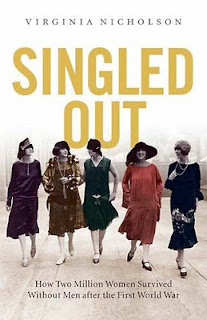One of the sub-sub-topics on one of my minor exams had to do with marital status as an analytic category in women's history, and one of my classmates must have known about that (probably I was venting loudly about it in the hallway at some point) because he sent me the information for this book in November. He kindly introduced it as something I would have already read; in fact I'd never heard of it. I read the introduction and the first chapter on the Ebrary software at our library, and was immediately drawn in. If you've ever had to endure Ebrary (or eBrary or whatever), you'll know it must have been good for me to read essentially two chapters rather than reading two pages and smashing my fist through the screen. Seriously, you know how Blackboard seems to have been designed in a world where Angelfire is cutting edge? Ebrary is worse, somehow.
(Before I move on, I want to register a complaint about the Kindle version: namely that it sucks. The chapters aren't marked, so you can't toggle forward, and whenever I click "previous page" it beams me back about five pages for some reason. Granted, my Kindle is starting to get slightly elderly and has started to do weird things, but I'm blaming this on the actual book. Which, FYI, cost me $10. Less than cool.)
I have a couple of historian's quibbles, which I suppose boil down to saying I would have done things differently. The author doesn't ignore class, but I thought at several points it could have been handled more explicitly. For instance, her descriptions of prewar expectations are pretty much limited to the debutante experience. The experience of different classes are there and acknowledged for the most part, but they're woven together, presumably because the author thinks the similarities are more important than the differences; a point I might take issue with, or if I agreed, it's a point I would be arguing as a new circumstance of the 1920s.
Which leads directly into my second criticism, which is that the presentation of change over time is also a little flat. The changes in the importance/perception/experience of marital status of the 1920s, however much directly caused by the First World War, were nevertheless part of longer shifts in the way people thought about sex, religion, family, etc. The book has a tendency to paint a sort of "before and after" picture that glosses over the particular development of ideas and trends. In many cases, being more specific would have helped her point (at least for me). Ironically, the "before and after" tactic actually muddles the changes in a lot of cases since her evidence doesn't always fit that sort of stark contrast. It's hard for me to describe this, but I felt on the whole that I was mentally supplying or clarifying a lot of the context.
And one very specific nitpick: there's a whole chapter about single women's attitude toward motherhood, which makes much reference to Victorian and Boer War-era notions about women as breeders, but manages to completely ignore the enormous attention paid to the children of dead soldiers in the 1920s! That's quite an oversight. And now that I think about it, there's no explicit mention of eugenic ideas either, even when she's talking about those ideas in relation to the Boer War. Basically what I'm saying is, this chapter completely drops the ball.
To be honest -- I'm only halfway through the book. It's starting to drag, it's felt repetitive for a while now (although this could easily just be me; clearly I have issues), and although Kindle assures me I'm right in the middle it's... daunting to imagine that. By far, the book's best asset is its source base; the author has pulled together an amazing range of first-hand accounts, many from very lowly women whose lives, trust me on this, are often hard to uncover. I'm dying to get to the bibliography. Curse you Kindle!
It's the anecdotes that are worthwhile. For the single woman (or at least, for me) it's interesting and even a little heartening to realize that people are people, and that many of the struggles single women (I) face today are things that women lived through back then. Many of the emotions experienced and strategies pursued are things that seem very relatable and even familiar today. Of course, loads of important things have changed, but the core drama of these women's lives is perfectly recognizable. Even if you read the book and think, "she's crazy pathetic, I don't identify with this at all," well, the book would really shed light on the various advantages of the present. (And stop judging me!) The book is full of really fascinating people, and in more than one case I wanted to find and read the whole biography being cited.
So by all means, obtain and then consume this book.* I would recommend getting it in paperback, which would make it easier to skim -- and check the bibliography. But I feel compelled to note that it fails more than it succeeds to really say anything about the interwar period or the way "singleness" developed as a result of the First World War. Then again, I haven't finished it, so take that as you will.
* Trying to change up my vocabulary.

No comments:
Post a Comment